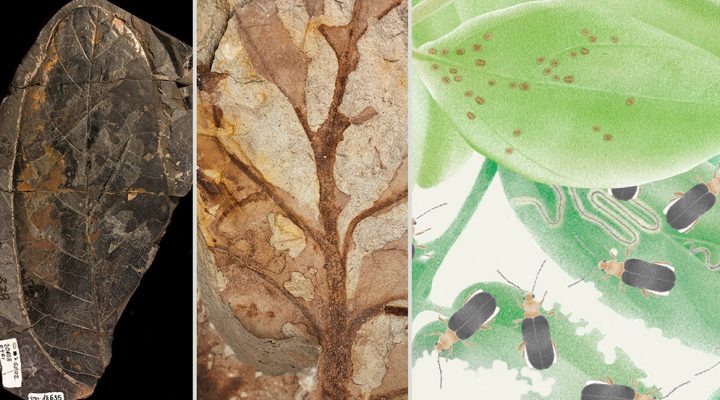BIOLOGICAL AND HEALTH SCIENCES
Scientists link the emergence of current tropical forests with the mass extinction at the end-Cretaceous
A research team analyzed what happened to the vegetation after the impact of the asteroid that led to the extinction of the dinosaurs. The study was published in Science.
An international research team concluded that current tropical forests are the result of a mass extinction that took place at the end of the Cretaceous, 66 million of years ago (Myr).
More than fifty thousand pollen grains, spores, and more than six thousand fossil leaves species found in Colombia were analyzed by a team of palynologists and paleobotanists of various institutions. It was led by Mónica Carvalho (Smithsonian Tropical Research Institute, Panamá – Facultad de Ciencias Naturales de la Universidad del Rosario, Colombia). The team evaluated how the rainforests have changed at the end of the Cretacious after the event that extinguished seventy five percent of species of the Earth.
The results indicated that after the impact of the asteroid that occurred in Chicxulub (Mexico), almost fifty percent of the plant species in the tropics of America became extinct and that led to a period of low diversity that lasted approximately six million years during the Paleocene.
The comparisons made between fossil and current forests (Amacayacu in Colombia and Isla Barro Colorado in Panamá) showed that those that emerged after the extinction were more similar to those of today than to their predecessors.
“In the tropical forests of late Creataceous, just before the extinction of the dinosaurs, flowering plants and ferns grew in equal proportions along with conifers, mainly araucarias. In these woods, the trees were distributed spaced apart allowing sunlight to reach the ground. However, during the Paleocene the forests were similar to modern tropical forests in which flowering plants dominate and the tree canopy is closed, preventing the passage of light and determining a complex vertical structure,” describes Paula Narváez, CONICET assistant researcher at the Instituto Argentino de Nivología, Glaciología y Ciencias Ambientales (IANIGLA, CONICET-UNCUYO-Gob.Mza), the only Argentine who participates in the study.
Furthermore, the study provides new data on the ecological characteristics of the herbivorous insects that inhabited before and after the extinction process: “The analysis of the damage marks produced by insects on the leaves allowed us to observe that towards the end of the Creataceous the herbivores were very specific since few plant species shared the same type of mark. However, in the Paleocene, the same types of bites were found in different plant species, so it is inferred that the insect communities were more generalists,” she comments.
The scientists demonstrated that the mass extinction at the end of the Cretaceous generated extreme ecological and evolutionary changes: “Although the same humid tropical climate prevailed, we observed that before and after the catastrophic event, the ecosystems were markedly different and are reflected in the composition and forest structure at both times. Therefore, one of the consequences of the meteorite impact was to produce the forest that today harbors the greatest diversity on the planet.
By Leonardo Fernández
References
Carvalho, M. R., Jaramillo, C., de la Parra, F., Caballero-Rodriguez, D., Herrera, F., Wing, S., Turner, B. L., D’Apolito, C., Romero-Baez, M., Narváez, P., Martinez, C., Gutierrez, M., Labandeira, C., Bayona, G., Rueda, M., Paez-Reyes, M., Cardenas, D., Duque, A., Crowley, J. L., Santos, C., & Silvestro, D. (2021). Extinction at the end-Cretaceous and the origin of modern Neotropical rainforests. Science. DOI:https://science.sciencemag.org/content/372/6537/63
About the study:
-Mónica R. Carvalho. Smithsonian Tropical Research Institute (STRI), Panamá. U. del Rosario, Colombia
-Carlos Jaramillo. STRI, Panamá. U. Montpellier, France. University of Salamanca, Spain.
-Felipe de la Parra. Instituto Colombiano del Petróleo, Colombia.
-Dayenari Caballero-Rodríguez. STRI, Panamá
-Fabiany Herrera. STRI, Panamá. Chicago Botanic Garden, USA.
-Scott Wing. National Museum of Natural History, USA
-Benjamin L. Turner. STRI, Panamá. University of Florida, USA.
-Carlos D’Apolito. STRI, Panamá. Universidade Federal de Mato Grosso, Brasil
Millerlandy Romero-Báez. STRI, Panamá. ExxonMobil Corporation, USA
–Paula Narváez. Instituto Argentino de Nivología, Glaciología y Ciencias Ambientales (CONICET)
-Camila Martínez. STRI, Panamá
-Mauricio Gutiérrez. STRI, Panamá. U. de Chile, Chile.
-Conrad Labandeira. National Museum of Natural History, USA. University of Maryland, USA. Capital Normal University, China.
-Germán Bayona. Corporación Geológica Ares, Colombia
-Milton Rueda. Paleoflora Ltda., Colombia
-Manuel Páez-Reyes. STRI, Panamá. University of Houston, USA.
-Dairon Cárdenas. Instituto Amazónico de Investigaciones Científicas SINCHI, Colombia
-Álvaro Duque. Universidad Nacional de Colombia, Colombia
-James L. Crowley. Boise State University, Boise, USA
-Carlos Santos. BP Exploration Operating Company Limited, UK.
-Daniele Silvestro. University of Fribourg, Switzerland. University of Gothenburg and Gothenburg Global Biodiversity Centre, Sweden.
